
*
1.3 – Images from My Phone
By: Joel Grey
Published by: Powerhouse Books
Publication Date: June 2, 2009
List price: $29.95, slipcased hardcover; 120 pages; 103 four-color photographs
"Whenever I see something I don't quite understand," says Joel Grey in the publisher's notes, "a shape, a color, an odd juxtaposition of the real and the abstract — nine times out of ten, it's my reason for taking the photograph. For me, taking pictures is like asking questions." In addition to being a Tony and Academy Award–winning actor (both for Cabaret), Grey is also an accomplished photographer, and this latest is his third published book of pictures. While visiting a small museum in St. Lucie, FL, in 2007, Grey's photographic eye became intrigued by a number of objects. But he had forgotten his ever-present Nikon. What to do? He grabbed his Nokia 133 cell phone — with its 1.3-megapixel lens (hence the title of the book) — and began shooting. At first unsure of the quality that would result from a cell phone that afforded none of the bells and whistles of a more sophisticated camera — like the ability to control aperture, focus, etc. — Grey rose to the challenge and spent the next eight months taking pictures with his phone, resulting in this collection of images of street life, still life, architecture, natural and urban settings. The book itself is something of a work of art, designed by Sam Shahid in his third collaboration with Grey. Go to www.imagesfrommyphonejoelgrey.com for more information or to see some of Grey's photos.
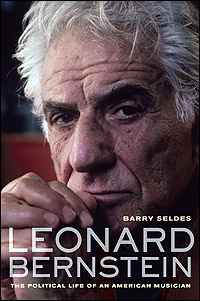 |
By: Barry Seldes
Published by: University of California Press
Publication Date: May 26, 2009
List price: $24.95, cloth; 296 pages; 9 b/w photographs
This new biography of Leonard Bernstein examines the composer and conductor's art through the prism of his political views and makes the case, according to publisher notes, that "Bernstein's great concert-hall and musical-theatrical achievements and his real and perceived artistic setbacks" were linked to his "involvement with progressive political causes." Bernstein's career, which began with a dazzling conducting debut in 1943 and ended with his death in 1990, took shape during a tumultuous time in American politics. With the Cold War raging, notes the publisher, he was blacklisted by the State Department in 1950, took voluntary exile from the New York Philharmonic in 1951 for fear that he might be blacklisted, signed a humiliating affidavit to regain his passport, and ultimately returned in triumph to the New York Philharmonic as the political climate of the mid-1950's began to change. Seldes, who is a professor of political science at Rider University, has utilized previously unpublicized FBI files and materials in the Library of Congress' Bernstein archive to make his case. His extensively documented biography not only adds to an understanding of Bernstein the artist but also reveals the often-overlooked intersection of politics and culture.
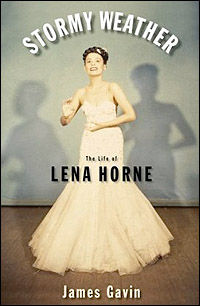 |
By: James Gavin
Published by: Atria Books/Simon and Schuster
Publication Date: June 2009
List price: $27, hardcover; 608 pages
When he was a teenager, author James Gavin was introduced to two Lena Horne albums — "Lena & Michel [Legrand]" and "Lena, A New Album" — and was moved by what he heard. As he describes it on his publisher's web site, "The sadness, anger, and disappointment I heard in her singing — the raw passion — touched me deeply, and led me on a search for all the Lena Horne recordings and movies I could find." On his journey, Gavin discovered a woman whose glamorous, sometimes glacial public persona hid deep wounds and frustrations, rooted in a difficult childhood and the blatant (and hidden) racism she encountered in a career that began in the glory days of Harlem's Cotton Club, passed through the M-G-M dream factory, where her talent was recognized but marginalized to guest spots in musicals, and took her to Broadway, where she starred in 1957's Jamaica, for which she was Tony-nominated, and triumphed to a Tony Award–winning turn in 1981's Lena Horne: The Lady and Her Music. In 1994 Gavin interviewed the legendary star for a piece in The New York Times, and he was once again impressed by the candor and vulnerability that captured him in those early recordings and belied the public face. These are the qualities of this complex American icon that he reveals in his new biography, via insights from Ruby Dee, Tony Bennett, Diahann Carroll, Arthur Laurents and even several of Horne's colleagues from her days as a Cotton Club chorine, as well as those he gained from his 1994 talk with the star who has inspired singers from Aretha to Streisand.
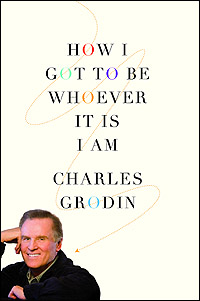 |
By: Charles Grodin
Published by: Springboard Press
Publication Date: April 9, 2009
List price: $24.99, hardcover; 272 pages
Anyone who's ever seen Charles Grodin in his guest spots on talk shows, his stint as a commentator for "60 Minutes II" or his current role as commentator for CBS News, or who has read his weekly op-ed column for the "New York Daily News" website knows that he is an articulate fellow with a dry wit. He is also a storyteller, and this memoir, his seventh book, finds the actor, author and activist in a reflective mood as he looks back on events both public and private that have shaped his life. From his impeachment as class president by his fifth grade teacher to being kicked out of Hebrew School for asking too many questions, Grodin learned early on how to deal with something that faces every actor: rejection. Absorbing those experiences, he found success in high school and college theatrics and chose a career as a professional actor, studying with teaching greats Uta Hagen and Lee Strasberg. Grodin tells behind-the-scenes tales of working on Broadway in Same Time, Next Year, in such films as "The Heartbreak Kid" and "Midnight Run" and how he came this close to getting the lead in "The Graduate," the part that brought fame to Dustin Hoffman. His star-studded stories feature many with whom he's worked: Robert DeNiro, Hoffman, Johnny Carson, Orson Welles, Warren Beatty, Robert Redford, Gene Wilder, to name a few. Grodin's other career — that of a commentator — is also covered in his memoir, as he writes about the political and personal aspects of journalism and insights he's gained from the people he's interviewed. As a mark of his personal commitment to his role as an activist, Grodin, according to publisher notes, "is donating 100 percent of his royalties from sales of this book to Mentoring USA, a New York City-based nonprofit [organization] that forges powerful, transformative connections for young people through the advocacy and involvement of mentors."
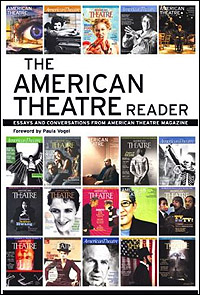 |
Edited by: The Staff of American Theatre Magazine
Published by: Theatre Communications Group
Publication Date: April 2009
List price: $24.95, paperback; 640 pages
American Theatre magazine marks its silver anniversary with this collection of significant articles, essays and interviews from its history. Over 100 artists, critics and theatre professionals are represented in this compilation, which reads like a Who's Who of the American theatre of the last quarter of a century. "The Reader" includes articles and essays by Eric Bentley, Peter Brook, Eisa Davis, Zelda Fichhandler, Athol Fugard, Tyrone Guthrie, David Henry Hwang, Adrienne Kennedy, Tony Kushner, Robert MacNeil, Marsha Norman, Suzan Lori-Parks, Hal Prince, Frank Rich, Wallace Shawn, José Rivera and Studs Terkel. The collection also includes conversations with Anne Bogart, Olympia Dukakis, Lorraine Hansberry, Jonathan Larson, Arthur Miller, Joseph Papp, John Patrick Shanley, Sam Shepard, Stephen Sondheim, Wole Soyinka, Luis Valdez and August Wilson. The book captures the diverse experience of these artists and, notes the publisher, makes this "essential reading for theatre professionals and theatergoers alike." But perhaps the devotion to American Theatre magazine is best summed up in the words of Pulitzer Prize–winning playwright Paula Vogel's Foreword: "I would run each month to the library in the days when I could ill afford a subscription and pester the librarian with the same impatience ('Is it in yet?') that 19th-century Americans possessed on the docks of New York, waiting for the next installment of Dickens' 'The Old Curiosity Shop' ('Is Little Nell dead?')."
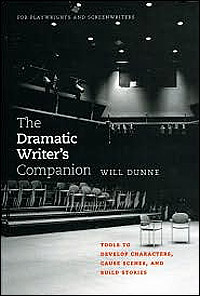 |
By: Will Dunne
Published by: The University of Chicago Press
Publication Date: April 2009
List price: $45, cloth; $19, paperback; 346 pages
Author Ray Bradbury once said, "First, find out what your hero wants. Then just follow him." Playwright and teacher Will Dunne might well agree. In his new handbook for writers Dunne adheres to the idea that character development is essential to telling a story. "The character is not something added to the scene or to the story," he writes. "Rather, the character is the story." Dunne employs his wealth of experience as the current resident playwright at Chicago Dramatists, a Charles MacArthur Fellowship honoree, a former O'Neill Theatre Center dramaturg and an award-winning author of such plays as How I Became an Interesting Person, Love and Drowning and Hotel Desperado to give writers a blueprint on how to examine their ideas in depth in order to develop their plays and screenplays. According to publisher notes, Dunne "blends condensed dramatic theory with specific action steps — over 60 workshop-tested exercises that can be adapted to virtually any individual writing process and dramatic script." To learn more about Dunne, his workshops and "The Dramatic Writer's Companion," go to www.willdunne.com.
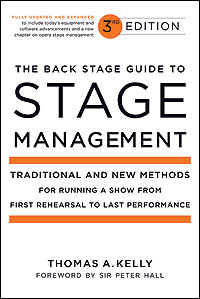 |
By: Thomas A. Kelly
Published by: Backstage Books
Publication Date: June 16, 2009
List price: $19.95, trade paperback; 304 pages
This third edition of Thomas Kelly's instructional guide for stage managers (it was first published in 1991, then again in 1999) imparts wisdom from his personal experience as a stage manager at various Broadway theatres, Lincoln Center and Chicago's Lyric Opera as well as that of other top-level stage managers. The book features practical information about all aspects of the stage manager's job, including, according to publisher notes "preproduction planning; organizing all rehearsals and performances; maintenance of the working script, cue sheets and daily records; supervision of the technical aspects of the show; and dealing with performers and crew members on all levels." Kelly's text is supported by visual aides such as diagrams and charts demonstrating rehearsal schedules, scene breakdowns, cue sheets, prop lists and much more. New in this edition is a section on stage management for the opera as well as information on the latest technological developments in stage machinery and computer software and tips for finding employment. *
Judy Samelson gathers information on theatre-related books, including published plays, for Playbill.com's monthly Shelf Life column. Write her at [email protected].









